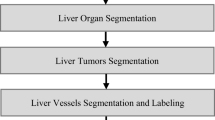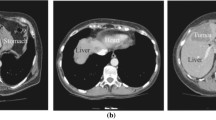Abstract
We developed a medical image segmentation and preoperative planning application which implements a semiautomatic and a hybrid semiautomatic liver segmentation algorithm. The aim of this study was to evaluate the feasibility of computer-assisted liver tumor surgery using these algorithms which are based on thresholding by pixel intensity value from initial seed points. A random sample of 12 patients undergoing elective high-risk hepatectomies at our institution was prospectively selected to undergo computer-assisted surgery using our algorithms (June 2013–July 2014). Quantitative and qualitative evaluation was performed. The average computer analysis time (segmentation, resection planning, volumetry, visualization) was 45 min/dataset. The runtime for the semiautomatic algorithm was <0.2 s/slice. Liver volumetric segmentation using the hybrid method was achieved in 12.9 s/dataset (SD ± 6.14). Mean similarity index was 96.2 % (SD ± 1.6). The future liver remnant volume calculated by the application showed a correlation of 0.99 to that calculated using manual boundary tracing. The 3D liver models and the virtual liver resections had an acceptable coincidence with the real intraoperative findings. The patient-specific 3D models produced using our semiautomatic and hybrid semiautomatic segmentation algorithms proved to be accurate for the preoperative planning in liver tumor surgery and effectively enhanced the intraoperative medical image guidance.





Similar content being viewed by others
References
Abdalla EK, Denys A, Chevalier P et al (2004) Total and segmental liver volume variations: implications for liver surgery. Surgery 135:404–410. doi:10.1016/j.surg.2003.08.024
Babalola KO, Patenaude B, Aljabar P et al (2009) An evaluation of four automatic methods of segmenting the subcortical structures in the brain. NeuroImage 47:1435–1447. doi:10.1016/j.neuroimage.2009.05.029
Center for Integrative Biomedical Computing (CIBC) (2015) Seg3D: volumetric image segmentation and visualization. Scientific computing and imaging institute (SCI). http://www.seg3d.org. Accessed 5 Jan 2015
Dawant BM, Li R, Lennon B, Li S (2007) Semi-automatic segmentation of the liver and its evaluation on the MICCAI 2007 grand challenge data set. In: Proceedings of MICCAI workshop on 3D segmentation in the clinic: a grand challenge, pp 215–221
Dello SAWG, van Dam RM, Slangen JJG et al (2007) Liver volumetry plug and play: do it yourself with ImageJ. World J Surg 31:2215–2221. doi:10.1007/s00268-007-9197-x
DuBray BJ Jr, Levy RV, Balachandran P et al (2011) Novel three-dimensional imaging technique improves the accuracy of hepatic volumetric assessment. HPB 13:670–674. doi:10.1111/j.1477-2574.2011.00350.x
Fedorov A, Beichel R, Kalpathy-Cramer J et al (2012) 3D Slicer as an image computing platform for the quantitative imaging network. Magn Reson Imaging 30:1323–1341. doi:10.1016/j.mri.2012.05.001
Grundmann RT, Hermanek P, Merkel S et al (2008) Arbeitsgruppe Workflow Diagnostik und Therapie von Lebermetastasen kolorektaler Karzinome. Diagnosis and treatment of colorectal liver metastases—workflow. Zentralblatt Für Chir 133:267–284. doi:10.1055/s-2008-1076796
Heimann T, van Ginneken B, Styner MA et al (2009) Comparison and evaluation of methods for liver segmentation from CT datasets. IEEE Trans Med Imaging 28:1251–1265. doi:10.1109/TMI.2009.2013851
Kohlberger T, Singh V, Alvino C et al (2012) Evaluating segmentation error without ground truth. In: Ayache N, Delingette H, Golland P, Mori K (eds) Medical image computing and computer assisted intervention—MICCAI 2012. Springer, Berlin, pp 528–536
MATLAB—the language of technical computing—A. http://www.mathworks.com. Accessed 6 Nov 2014
Ohshima S (2014) Volume analyzer SYNAPSE VINCENT for liver analysis. J Hepato-Biliary-Pancreat Sci 21:235–238. doi:10.1002/jhbp.81
Simpson AL, Dumpuri P, Jarnagin WR, Miga MI (2012) Model-assisted image-guided liver surgery using sparse intraoperative data. In: Payan Y (ed) Soft tissue biomechanical modeling computer assisted surgery. Springer, Berlin, pp 7–40
SLIVER07: home. http://sliver07.org/. Accessed 27 Jan 2015
Soler L, Nicolau S, Pessaux P et al (2014) Real-time 3D image reconstruction guidance in liver resection surgery. Hepatobiliary Surg Nutr 3:73–81. doi:10.3978/j.issn.2304-3881.2014.02.03
Takamoto T, Hashimoto T, Ogata S et al (2013) Planning of anatomical liver segmentectomy and subsegmentectomy with 3-dimensional simulation software. Am J Surg 206:530–538. doi:10.1016/j.amjsurg.2013.01.041
Van der Vorst JR, van Dam RM, van Stiphout RSA et al (2010) Virtual liver resection and volumetric analysis of the future liver remnant using open source image processing software. World J Surg 34:2426–2433. doi:10.1007/s00268-010-0663-5
Vauthey JN, Chaoui A, Do KA et al (2000) Standardized measurement of the future liver remnant prior to extended liver resection: methodology and clinical associations. Surgery 127:512–519. doi:10.1067/msy.2000.105294
Yang X, Yu HC, Choi Y et al (2014) A hybrid semi-automatic method for liver segmentation based on level-set methods using multiple seed points. Comput Methods Programs Biomed 113:69–79. doi:10.1016/j.cmpb.2013.08.019
Yushkevich PA, Piven J, Hazlett HC et al (2006) User-guided 3D active contour segmentation of anatomical structures: significantly improved efficiency and reliability. NeuroImage 31:1116–1128. doi:10.1016/j.neuroimage.2006.01.015
Zahel T, Wildgruber M, Ardon R et al (2013) Rapid assessment of liver volumetry by a novel automated segmentation algorithm. J Comput Assist Tomogr 37:577–582. doi:10.1097/RCT.0b013e31828f0baa
Acknowledgments
This study was supported by a grant for Ph.D. studies from the Onassis Foundation. Thanks are due to Dr. G. Drosou (Biologist) for her indications on 3D visualization. Thanks are due to Mrs. A. Skoura (Computer Engineer) for her help in analysis of anatomical tree-shape structures.
Funding
This study was supported by a grant for Ph.D. studies from the Onassis Foundation.
Author information
Authors and Affiliations
Corresponding author
Ethics declarations
Conflict of interest
Author ZA has received research grants from the Onassis Foundation. All the other authors declare that they have no conflict of interest.
Ethical approval
All procedures performed in studies involving human participants were in accordance with the ethical standards of the institutional and/or national research committee and with the 1964 Helsinki declaration and its later amendments or comparable ethical standards.
Rights and permissions
About this article
Cite this article
Zygomalas, A., Karavias, D., Koutsouris, D. et al. Computer-assisted liver tumor surgery using a novel semiautomatic and a hybrid semiautomatic segmentation algorithm. Med Biol Eng Comput 54, 711–721 (2016). https://doi.org/10.1007/s11517-015-1369-5
Received:
Accepted:
Published:
Issue Date:
DOI: https://doi.org/10.1007/s11517-015-1369-5




